The Unsung Hero: Your Toilet Shut-Off Valve
In the realm of household plumbing, one component often gets overshadowed by the glitz and glam of modern fixtures: the toilet shut-off valve. While it might not be the star of the show, this unassuming device plays a critical role in maintaining your toilet’s functionality and preventing potential disasters. In this article, we’ll delve into the significance of the toilet shut-off valve, its purpose, and why knowing how to operate it is a must for every homeowner.
The Role of the Toilet Shut-Off Valve
Have you ever considered what you would do if your toilet started overflowing uncontrollably? This is where the toilet shut-off valve steps in as your lifesaver. The shut-off valve is strategically placed on the water supply line that feeds water to your toilet tank. It serves as a means to cut off the water flow to the toilet in situations of emergencies, repairs, or maintenance.
Locating the Toilet Shut-Off Valve
Before you can harness the power of your toilet shut-off valve, you need to pinpoint its location. You’ll typically find it on the wall behind or beside the toilet. Sometimes, it’s concealed within a decorative cap. If you’re uncertain, follow the water supply line from the bottom of the toilet tank to the wall – you’re likely to stumble upon the shut-off valve there.
Operating the Valve
Knowing how to operate the toilet shut-off valve is crucial, especially when dealing with toilet-related mishaps. Here’s a step-by-step guide:
- Locate the Valve: Find the shut-off valve and ensure there’s easy access to it.
- Turn Clockwise: Turn the valve’s handle clockwise until it’s snugly closed. This halts the water flow to the toilet.
- Test the Flow: Flush the toilet to confirm that the water flow has stopped. If water continues to flow, the valve might need further tightening or maintenance.
- Open Faucet: To release any pressure in the water line, open a nearby faucet after shutting off the valve.
Maintenance and Care
While the toilet shut-off valve might be a low-maintenance component, it’s essential to give it occasional attention:
- Regular Checks: Inspect the valve for signs of corrosion, rust, or leakage. If you notice any issues, consider having it replaced.
- Exercise Annually: To prevent the valve from seizing up due to inactivity, turn it on and off once a year.
- Keep Accessible: Ensure that the valve remains easily accessible and isn’t blocked by obstacles.
